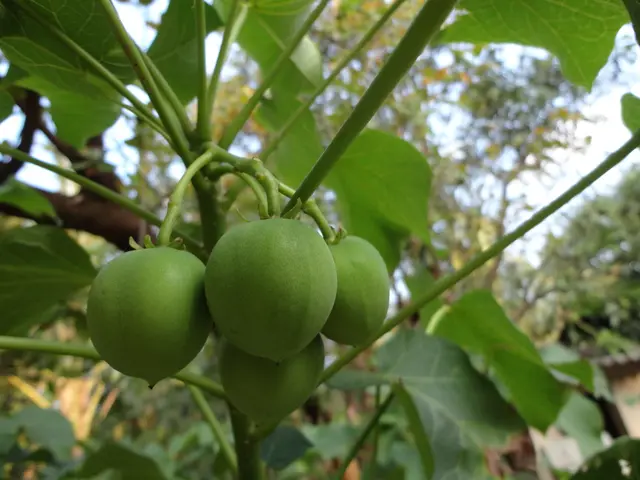Guide on Cultivating a Butterfly Bush Attracting Abundant Pollinators
Ready to transform your yard into a pollinator haven? Butterfly bushes can help bring in an array of butterflies, bees, and even hummingbirds! But remember, it takes more than a shovel and some sunlight to make your butterfly bush flourish. Here's a step-by-step guide to cultivating a pollinator-friendly butterfly bush from the ground up.
1. Enrich Soil with Compost
First things first — improve your soil! Add compost before planting to give your butterfly bush the perfect foundation for growth. Compost not only improves the soil's texture but also adds essential nutrients for healthy leaves and blooms. Sprinkle a few inches of compost into the planting hole and mix it with the existing soil for a nutrient-rich start.
2. Keep pH Balanced (6.0 – 7.5)
Butterfly bushes thrive in mildly acidic to neutral soil with a pH between 6.0 and 7.5. Use a testing kit to check your soil's pH and make adjustments as needed with gardening products. Maintaining the right pH ensures your plant stays healthy and blooms profusely.
3. Moderate the Fertilizer
Too much fertilizer can do more harm than good! Excess nutrients can cause the plant to grow tall and thin with fewer flowers. Opt for a light touch to keep your plant balanced and promote more nectar-rich flowers.
4. Choose the Ideal Cultivar
Butterfly bushes are not a one-size-fits-all situation. Select a cultivar that matches your USDA zone for quicker and healthier growth. If space is limited, try newer, compact types to save room in your garden. And remember, always choose sterile varieties to avoid invasive growth!
5. Plant in Full Sun
Butterfly bushes love the sun and need at least six to eight hours of direct sunlight per day to flourish. Position your plant in a sunny spot to encourage bright blooms and attract even more pollinators.
6. Manage Unwanted Seedlings
Butterfly bushes can spread on their own, often forming unwanted seedlings. Remove these young plants to ensure your garden stays neat and controlled.
7. Ensure Good Drainage
Butterfly bushes hate soggy soil! Make sure your planting area has excellent drainage to prevent root rot and other issues. Consider raised beds if your soil is heavy or clay-based.
8. Space Plants Appropriately
Proper spacing allows plants to breathe and encourages healthy growth. Keep at least four to six feet apart to allow for air circulation and plenty of room for butterflies to move between blooms.
9. Add Pollinator-Friendly Companion Plants
Butterflies crave variety! Surround your butterfly bush with other pollinator favorites like bee balm, coneflowers, black-eyed Susans, and milkweed. These plants offer nectar at different times of the year, making your garden more inviting.
10. Plant Host Species for Caterpillars
Plant preferred host plants for butterfly caterpillars to support the entire life cycle of these beautiful creatures. For example, monarchs need milkweed, while black swallowtails love parsley and dill.
11. Offer Tubular Flowers for Hummingbirds
In addition to butterflies, hummingbirds can't resist tubular, nectar-rich flowers like salvia, penstemon, and cardinal flower. Bring extra life to your garden by planting these blooms alongside your butterfly bush.
12. Water Deeply Once a Week
Water your butterfly bush deeply, but only once a week, to encourage strong root growth. This prevents shallow roots near the surface and helps the plant handle hot weather.
13. Use Mulch to Retain Moisture
Mulch offers many benefits! It helps maintain soil moisture, reduces weed growth, and regulates soil temperature. A good mulch layer supports steady, healthy growth.
14. Deadhead to Encourage More Blooms
Trim spent blooms routinely to stimulate your butterfly bush to produce more flowers. This simple step ensures your plant continues to attract pollinators throughout the season.
15. Prune Back in Early Spring
Prune your butterfly bush shortly after the last frost to promote healthy growth. Trim the stems down to about 12 inches to remove dead wood and stimulate new growth. This also helps shape your bush and keeps it from becoming too large.
16. Avoid Pruning in Fall
Late pruning can expose tender new growth to frost, which may harm your bush. Wait until spring to trim again to protect your plant during colder months.
17. Feed Lightly in Spring
In early spring, provide light feeding with a balanced fertilizer like 10-10-10 to support strong growth. Stay away from overfeeding, as this can lead to weak growth and fewer blooms.
18. Minimize Harmful Pesticides
Insecticides can harm our pollinator friends. Opt for natural pest control methods or manually remove pests whenever possible. Keep your garden chemical-free for the safety of all pollinators.
19. Provide Water for Pollinators
Offer a shallow dish of water with stones for bees and butterflies to drink fresh water and rest. Remember to clean and refill this dish regularly.
20. Offer Sunny Rocks for Basking
Butterflies need warmth to fly, so place flat stones in sunny spots for them to warm up in the mornings. This simple act encourages more butterfly activity in your garden.
21. Leave Leaf Litter in Fall
Instead of cleaning up all those leaves, let them stay to provide habitat for insects during winter. This nutrient-rich material also adds organic matter to your soil over time.
22. Leave Seed Heads for Birds
Encourage birds to visit by leaving seed heads on your butterfly bush and other plants during winter. This food source helps them survive when bugs are scarce.
23. Delay Spring Cleanup
Resist the urge to clean up in early spring. Overwintering pollinators may still be resting in the dead stems and leaves, so give them time to wake up and move on.
24. Regularly Monitor Plant Health
Regularly inspect your butterfly bush for signs of disease or pests. Catching problems early allows you to take quick action and keep your plant healthy.
By following these guidelines, you'll create a stunning garden that pollinators will love for months to come! Happy gardening, and may your yard flourish with vibrant life! 🦋🐝🐦🦉🌱
Here are the sentences that meet the requirement:
- Incorporating pollinator-friendly plants, such as bee balm and milkweed, in your home-and-garden or environmental-science projects can help create a welcoming environment for butterflies, bees, and hummingbirds.
- To enhance the eco-friendliness of your lifestyle, consider growing flowering plants like salvia and cardinal flower, often found in gardening books, as they attract pollinators and contribute to a healthier ecosystem.








